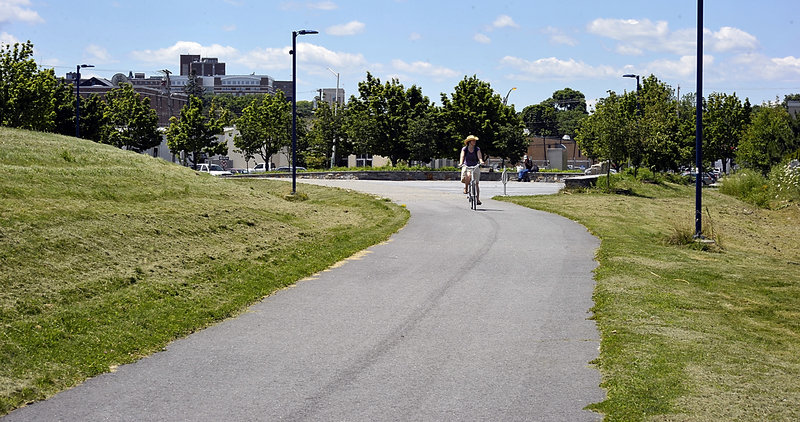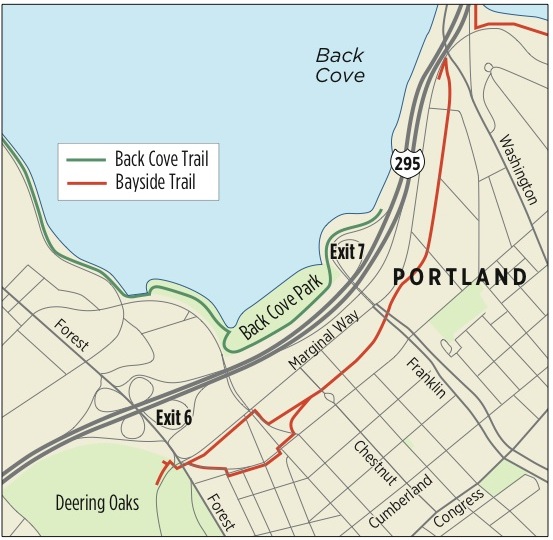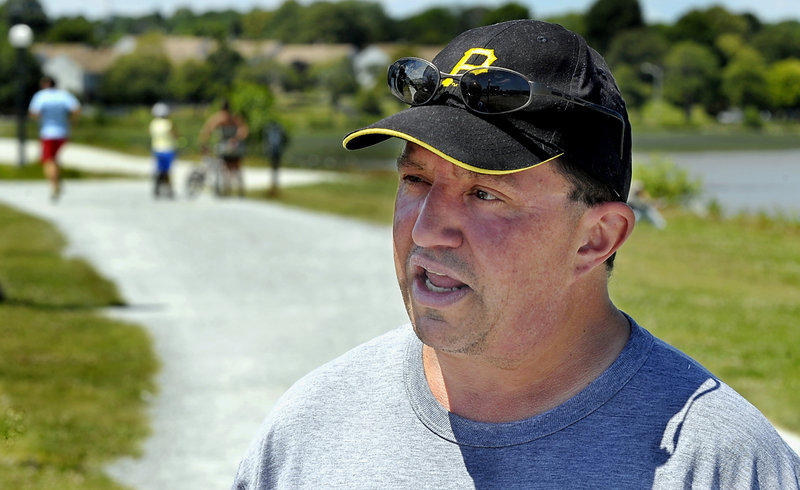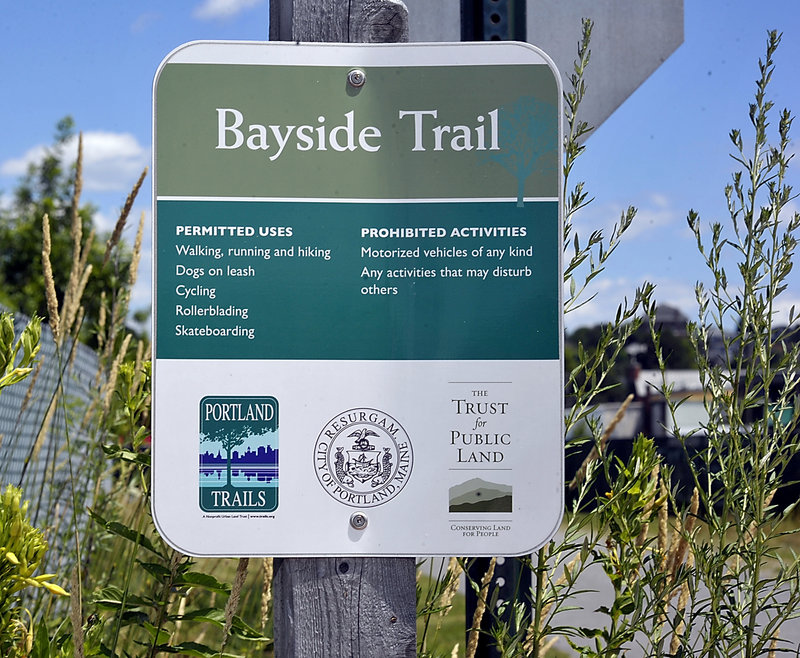PORTLAND – Completed two years ago this summer, Portland’s $5 million Bayside Trail has benches, plazas and grassy slopes where office workers can sit and eat lunch. The 1.2-mile trail has everything a great urban trail needs, except one thing:
People.
At noon on a beautiful day this week, no one was eating lunch along the trail. Over the next half-hour, a total of seven pedestrians and two bicyclists were seen on it — a small fraction of the number of midday users on the Back Cove Trail, the popular loop trail on the other side of Interstate 295.
Portlanders who avoid the Bayside Trail say it doesn’t go anywhere and it seems more isolated and less safe than other trails in the city.
Its proponents say it’s unfair to compare the new “connector” trail with destination trails with water views, like the Back Cove Trail or the East End Trail. And they say it’s too soon the judge the success of the trail because the Bayside neighborhood is on the verge of major development that will make the area much more populated and vibrant.
The city has been negotiating for several months with the Federated Cos., a Miami-based developer that plans to build a million-square-foot, mixed-use project on city-owned land on Somerset Street, between Elm and Pearl streets. Somerset Street runs parallel to the Bayside Trail.
The project would include more than 500 market-rate apartments, two parking garages and commercial space on the first floors. City officials hope to announce the deal by the end of this year.
The development would put more people in Bayside, and the trail would connect those people to other trails in the city, said Rick Knowland, a senior planner with the city of Portland.
Since the trail was built, he said, its use has been on the rise as more people have discovered it. He said he is pleased with the current level of activity there.
The Bayside Trail represents an investment in infrastructure, much like roads and utilities for a business park, said Greg Mitchell, the city’s economic development director.
He said the trail is critical to Portland’s efforts to lure investment to Bayside because it shows that the city is committed to redeveloping the once-blighted area. An artist’s sketch of the city’s vision just isn’t as convincing as the real thing, he said.
The trail follows the old Union Branch railroad easement. The rail yard, west of Franklin Street between Marginal Way and Somerset Street, was built in 1910 in a filled-in swamp. The yard was taken out of service in the 1980s.
The city bought the property in 2005 for $1.5 million. The money for the trail came from a combination of federal and state sources, including $800,000 in federal stimulus funds.
Two-thirds of the money has been spent to improve the drainage in the area and remove or cover up contaminated soil with 18 inches of clean soil.
In the second phase of the project, the city plans to extend the trail about five blocks to Forest Avenue when it rebuilds Somerset Street. The city will soon seek proposals for planning that phase of the project, Knowland said.
Today, because of vacant lots along the trail, the stretch west of Franklin Street seems isolated from the rest of the city, creating the perception that it’s unsafe, said Daniel Knight, a lead officer in the city’s community policing initiative whose district includes the trail.
“There aren’t many people down there,” he said. “There are more homeless than anybody else.”
Abigail Endl, 29, of Portland said she doesn’t feel safe on the trail. When she lived in Bayside, she said, she would drive to the Back Cove Trail to get some exercise.
“It’s kind of secluded,” she said of the Bayside Trail. “There are lots of people hanging around you won’t want to walk by.”
Michael VanDerburgh, who prefers to walk on the Back Cove Trail, said I-295 is a dividing line. “People fear what’s on the other side of the interstate,” he said.
The facts don’t back up any perception that the Bayside Trail is more dangerous, Knight said. He said he’s not aware of any violent crimes on the trail.
Trail users say the Bayside Trail has other obstacles to increasing use.
The trail connects with the Eastern Promenade Trail and the Back Cove Trail, but ends abruptly at Elm Street. Proponents note that extending it to Forest Avenue would connect it with Deering Oaks.
Also, Franklin Street — the four-lane crosstown arterial — cuts the trail into two sections. Trail users who cross the street have to detour around a fence that the Maine Department of Transportation put up in the median.
Many trail users find busy Franklin Street too intimidating and turn around or look for another route, such as Marginal Way, said Christian MilNeil, an advocate for alternative transportation.
He said the portion of the trail east of Franklin Street is the most heavily used section, and its use will increase when the Portland Housing Authority moves forward with its plan to build a trail connection through Kennedy Park to Boyd Street.
The trail will be wide enough for police cruisers, so police will have quicker access to the neighborhood in emergencies.
The Bayside Trail will prove its worth when development transforms the Bayside neighborhood and brings in new businesses and hundreds of families, said Ron Spinella, president of the Bayside Community Development Corp.
“It’s true it is lightly used,” he said. “I don’t think it was a mistake to build it, though. We haven’t seen some of the build-up that will occur.”
Staff Writer Tom Bell can be contacted at 791-6369 or at:
tbell@pressherald.com
Send questions/comments to the editors.






Comments are no longer available on this story